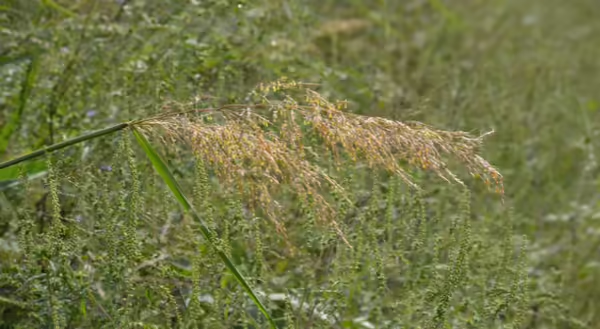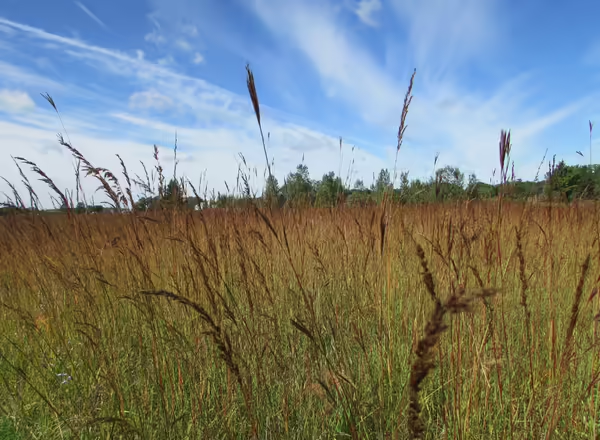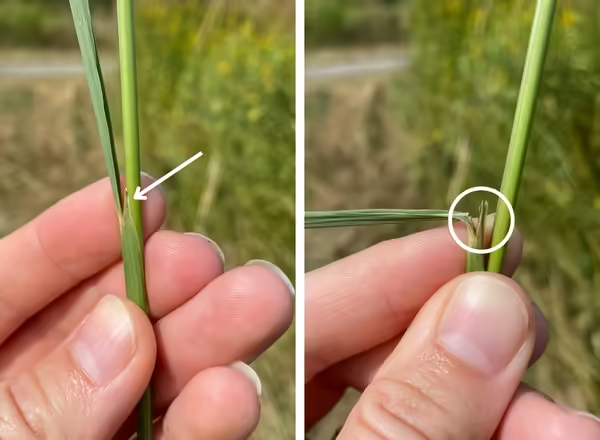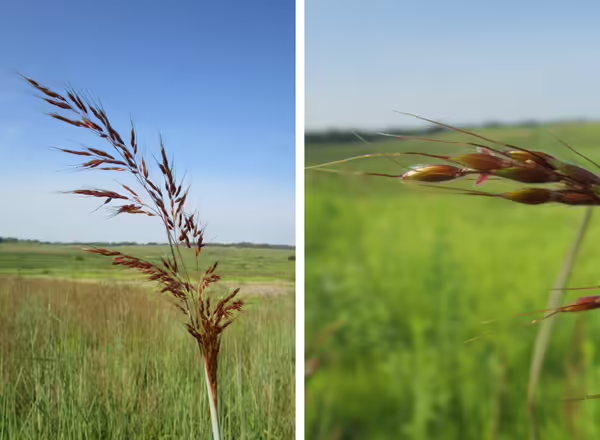
While driving from one end of Illinois to the other and back this past week, I enjoyed seeing the abundance of Indiangrass carpeting the median strips. The blue-green foliage is topped with golden-orange panicles of smooth, soft spikelets. Indiangrass (Sorghastrum nutans) is one of my favorite grasses to teach others to identify, because it has so many distinctive characteristics. Let’s take a look.
Range and habitat
Indiangrass is very common in Illinois, occurring in all 102 counties. It is one of the three dominant prairie grasses iconic of the tallgrass prairie ecosystem. Besides prairies, you can find it in savannas and along roadsides.

Height and growth habit
Indiangrass typically grows between 5 and 7 feet tall. Its height is one way to start to distinguish it from other grasses. As mentioned above, when you see a big clump of it growing, the blue-green hue of the stems and leaves is apparent, standing out from the brighter or deeper true greens of other grasses. It is a bunchgrass, growing in tight bunches, yet when growing in a monoculture, the bunch form is hard to detect.
A grass with horns
Indiangrass is unique in that it has a feature called horns in the collar region where the leaf blade wraps around the stem to form a sheath. Horns are stiff plant material extending up from the leaf sheath (below). It’s a bit easier to see the horns when looking at the stem from a side view (below left), but can also be seen when you pull the leaf blade back from the stem (below right). You can also look for a membranous ligule and hairy nodes along the stem.
Flowers ready for fall
You know fall is coming when the Indiangrass starts to bloom, as it starts to show some fall color. It produces a panicle inflorescence with more contracted branches than the typical open, airy panicle shape. Awned spikelets are orange to golden and covered in silky hairs. If you catch it in bloom, you can see yellow anthers exserted from the spikelets that dance in the wind.


Never miss a new post! Sign up for our email list.
ABOUT THE AUTHOR: Erin Garrett is a Natural Resources, Environment, and Energy Educator for University of Illinois Extension serving Alexander, Johnson, Massac, Pulaski, and Union counties. Erin develops and delivers high impact programming to adults and youth to help them develop an appreciation for natural resources and to empower them to make small changes to positively impact the environment. Erin’s programming focuses on why homeowners should consider choosing native plants, how to support native pollinators, how to identify grasses, how to identify and manage invasive species, and developing an appreciation for prairie ecosystems.
ABOUT THE BLOG: Grasses at a Glance dives into grass identification, focusing on tips and tricks that make grass identification possible. Get information about native and non-native species, how to tell look-alikes apart, and which grasses you can find in Illinois.
Indian Grass, Sorghastrum nutans, is a native, warm season grass of the tallgrass prairie. It is a robust bunchgrass that can grow between four and seven feet tall. Its stems are blue-green in color which can make it stand out from the surrounding foliage, and the leaves are over a foot...